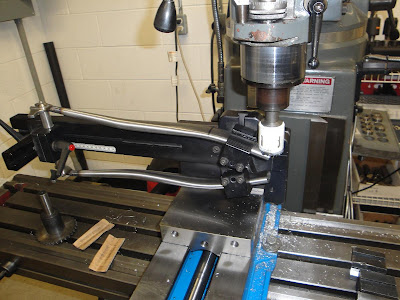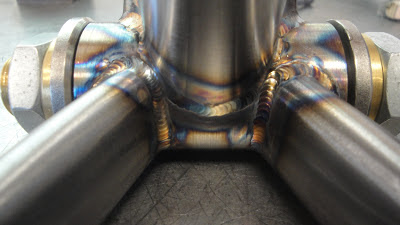To make a visual representation of the basic rear end geometry, I use a steel table and begin by using the edge closest to me as my axle line. I draw a line perpendicular to the tables edge to represent the center line of the frame in it's long axis, a little longer than the length of my anticipated chainstay length, in this case 440mm. Moving back to my axle line/edge, I then measure out lateral to both sides of my perpendicular center line one half my desired rear end spacing (135mm, measured and marked at 67.5mm) and make a mark with a Sharpe; this represents the inside aspect of each dropout.
I then measure and extend my dropout indicator line for the length and width of the dropout tang, coloring it in. I now have a visual representation of my dropout position relative to my frame center line.
Measuring from the center of the dropout to the terminal end of the tang...
Transferring that measurement to the table from my small dropout indicator mark...
Measuring the width of the dropout tang and transferring it to the table...you can see I now have a visual representation of the actual distance the dropout is from the axle center line and it's width marked on the table as the thicker black line.
Measuring forward from my axle line, I can then create a parallel line that represents the center of my bottom bracket. I'm using a 1.500" x 68mm bottom bracket shell, so now I need to create that on my drawing. Measuring and marking .750" parallel off that line gives me the apex of my bottom bracket shell. Measuring and marking lateral half the width of my intended shell, 68mm in this case, gives me my bottom bracket face for each side. I connect the dots and now have my bottom bracket position.
Measuring the distance to the center of my bottom bracket along my bicycle center line...
and drawing in it's outer parameters...
Next, it'll be nice to know where my tire falls in this drawing. I'm going to set this drawing up for my customer's largest tire, a 2.400" knobby. The widest portion of the tire falls at 13.500" from the axle line with the peak frontal edge at 14.500" for this 29er rubber. I'll draw this representation, using the center line and axle line as datum points, then connect the dots.
Here I've taken the dimensions from the Shimano spec and transferred them to my drawing, using x and y coordinates to locate the chainrings off of the center line of the bike and the center line of the bottom bracket. This drawing is reflective of a Shimano XTR 40/28 crank set up.
Now that all my critical dimensions are known, I can begin to shape my stays to accomplish a few items; clearance around the tire, clearance for the rings, clearance for the rider's heel.
I mark my stays in tandem to insure symmetry, including the apex of the bend where the tire will be located and my bend datum point where I will anchor each tube for shaping. I'll then bend the tubes and crimp the stay for the apex of tire using special dies I machined for this purpose.
Here you can see the chain stay being supported by an oval profiled die and it's corresponding curved piece that will create the crimp on the center line of the tube. I've matched the apex of the bend up with the apex of the curve in the press to insure a smooth indent in the correct location...
I will then lay out the stays on the table drawing, lining up the apex of the bend with the widest point of the tire, to insure that I have no interference issues at any of the critical areas while insuring good placement on the bottom bracket and dropout. With the worst case scenario tire, it looks like I'll have .250" clearance for both the rubber and the chain rings to either side of my profiled stay.
While on the table, I will note the point where the end of the dropout tang terminates on the stay and then measure down the stay toward the dropout another 12 mm; the amount that I want the stay to encompass the dropout tang for brazing. I will also note the angle the dropout intersects the stay, as this will become the angle necessary for my slot in the stay to receive the tang.
I mark where the stay will meet the bb as well, that way I have a reference point when setting up for mitering as to where my apex of my cutter will be.
The excess tubing is cut off and deburred, then it's off to the mill for mitering. The tube is held parallel to the table and a double slitting saw is positioned at the correct angle and depth to make the cut for our dropout.
The slitting saw is run through the tube end with copious lubricant and then the center "tooth" of the machined tube is grabbed with needle nose pliers and bent a time or two until it comes off.
A quick rinse to get rid of the oils, a few strokes with a round file and then she's checked for fit...
I will then fixture up the stay and the dropout and braze it up...
After cleaning, back into the frame fixture it goes and I will weld up the chain stays and then move my focus to the seat stays, repeating many of the same steps.
I start off with straight stays and using my table dimensions, begin determining where the tube needs manipulated. Once bent up, I place the seat stays on the table, placing the apex of the bend where the widest portion of the tire is and note where the stays meet the dropout tangs and the center line of the seat tube. Mark it up as before, chop it, and miter it...
One stay mitered for the dropout, one to go...
Alright, you are there. All that is left is to cut in for your seat tube miter and you've got a rear end that matches your intended design with appropriate clearances...congrats!



No comments:
Post a Comment